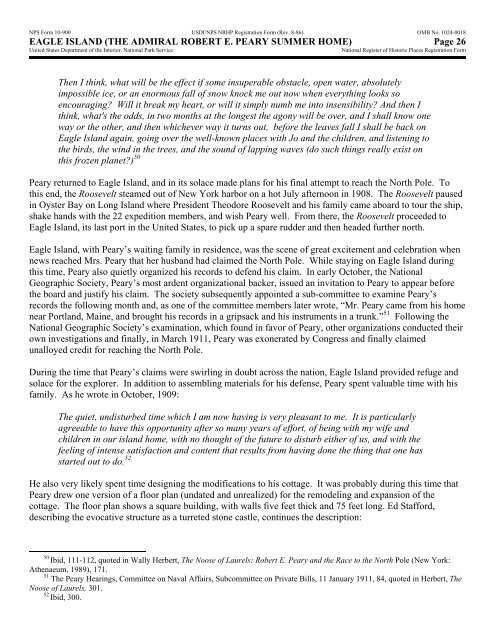Nomination - National Park Service
Nomination - National Park Service
Nomination - National Park Service
Create successful ePaper yourself
Turn your PDF publications into a flip-book with our unique Google optimized e-Paper software.
NPS Form 10-900 USDI/NPS NRHP Registration Form (Rev. 8-86) OMB No. 1024-0018<br />
EAGLE ISLAND (THE ADMIRAL ROBERT E. PEARY SUMMER HOME) Page 26<br />
United States Department of the Interior, <strong>National</strong> <strong>Park</strong> <strong>Service</strong><br />
<strong>National</strong> Register of Historic Places Registration Form<br />
Then I think, what will be the effect if some insuperable obstacle, open water, absolutely<br />
impossible ice, or an enormous fall of snow knock me out now when everything looks so<br />
encouraging? Will it break my heart, or will it simply numb me into insensibility? And then I<br />
think, what's the odds, in two months at the longest the agony will be over, and I shall know one<br />
way or the other, and then whichever way it turns out, before the leaves fall I shall be back on<br />
Eagle Island again, going over the well-known places with Jo and the children, and listening to<br />
the birds, the wind in the trees, and the sound of lapping waves (do such things really exist on<br />
this frozen planet?) 50<br />
Peary returned to Eagle Island, and in its solace made plans for his final attempt to reach the North Pole. To<br />
this end, the Roosevelt steamed out of New York harbor on a hot July afternoon in 1908. The Roosevelt paused<br />
in Oyster Bay on Long Island where President Theodore Roosevelt and his family came aboard to tour the ship,<br />
shake hands with the 22 expedition members, and wish Peary well. From there, the Roosevelt proceeded to<br />
Eagle Island, its last port in the United States, to pick up a spare rudder and then headed further north.<br />
Eagle Island, with Peary’s waiting family in residence, was the scene of great excitement and celebration when<br />
news reached Mrs. Peary that her husband had claimed the North Pole. While staying on Eagle Island during<br />
this time, Peary also quietly organized his records to defend his claim. In early October, the <strong>National</strong><br />
Geographic Society, Peary’s most ardent organizational backer, issued an invitation to Peary to appear before<br />
the board and justify his claim. The society subsequently appointed a sub-committee to examine Peary’s<br />
records the following month and, as one of the committee members later wrote, “Mr. Peary came from his home<br />
near Portland, Maine, and brought his records in a gripsack and his instruments in a trunk.” 51 Following the<br />
<strong>National</strong> Geographic Society’s examination, which found in favor of Peary, other organizations conducted their<br />
own investigations and finally, in March 1911, Peary was exonerated by Congress and finally claimed<br />
unalloyed credit for reaching the North Pole.<br />
During the time that Peary’s claims were swirling in doubt across the nation, Eagle Island provided refuge and<br />
solace for the explorer. In addition to assembling materials for his defense, Peary spent valuable time with his<br />
family. As he wrote in October, 1909:<br />
The quiet, undisturbed time which I am now having is very pleasant to me. It is particularly<br />
agreeable to have this opportunity after so many years of effort, of being with my wife and<br />
children in our island home, with no thought of the future to disturb either of us, and with the<br />
feeling of intense satisfaction and content that results from having done the thing that one has<br />
started out to do. 52<br />
He also very likely spent time designing the modifications to his cottage. It was probably during this time that<br />
Peary drew one version of a floor plan (undated and unrealized) for the remodeling and expansion of the<br />
cottage. The floor plan shows a square building, with walls five feet thick and 75 feet long. Ed Stafford,<br />
describing the evocative structure as a turreted stone castle, continues the description:<br />
50<br />
Ibid, 111-112, quoted in Wally Herbert, The Noose of Laurels: Robert E. Peary and the Race to the North Pole (New York:<br />
Athenaeum, 1989), 171.<br />
51 The Peary Hearings, Committee on Naval Affairs, Subcommittee on Private Bills, 11 January 1911, 84, quoted in Herbert, The<br />
Noose of Laurels, 301.<br />
52<br />
Ibid, 300.
















